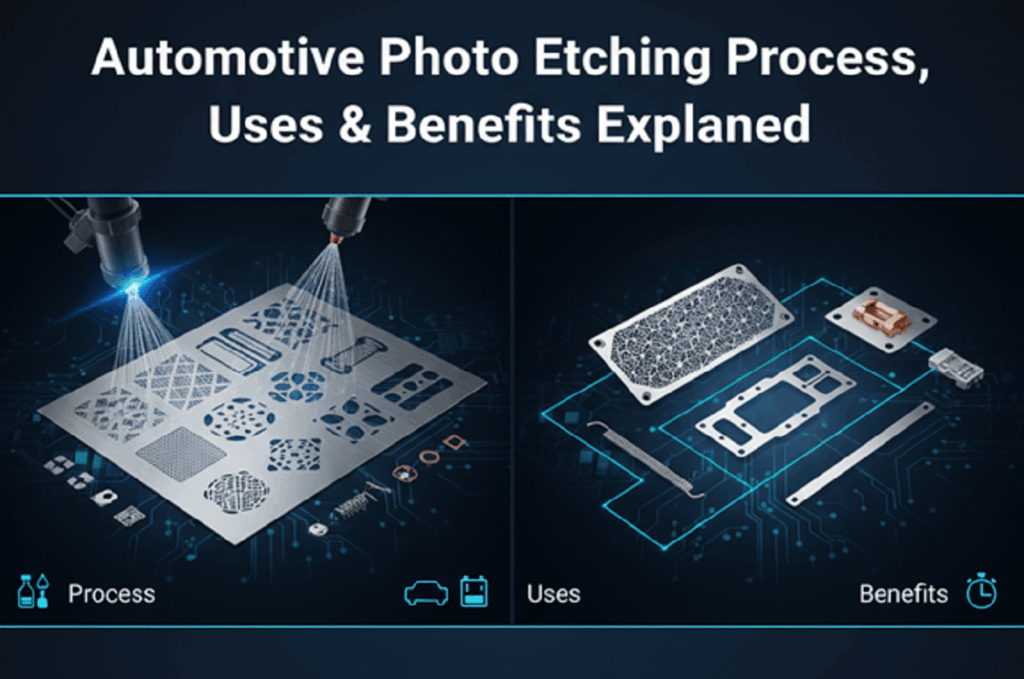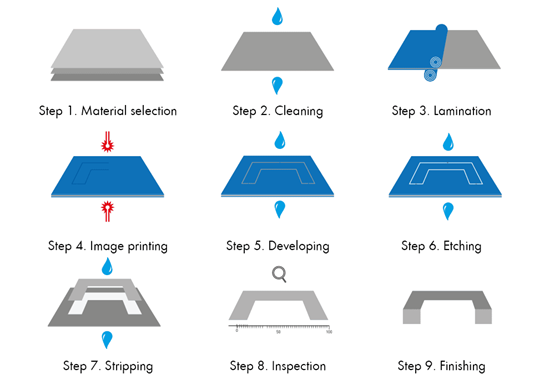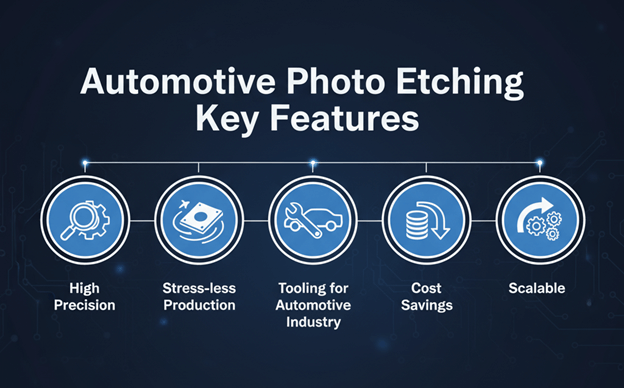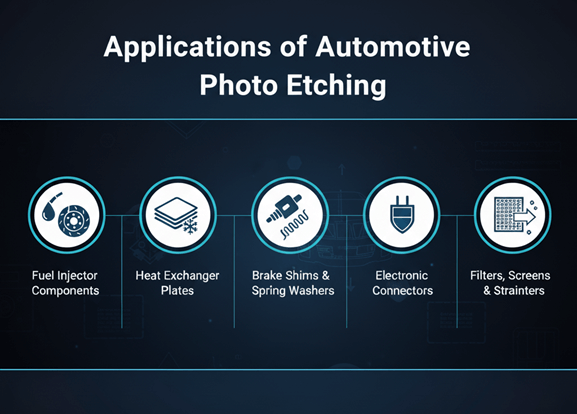Automotive photo etching components are one of the most accurate and consistent methods of manufacturing vehicle parts. The automotive photo etching process helps the auto industry to obtain high accuracy, low cost, and high quality. Photochemical etching for automotive applications produces durable components with complex geometry from intricate metal parts. TMNetch, as a trusted solution provider, keeps supporting the automotive sector with advanced photo etching for automotive industry solutions.

What Is Automotive Photo Etching?
In the automotive industry, automotive photo etching is a manufacturing method that utilizes photoresist and chemical etching to create intricate and highly accurate automotive components. It allows you to produce thin metal parts with consistent quality with no mechanical stress. It has become widely adopted because machining, a conventional process that many engineers prefer, often fails their delicate automotive designs.
Composition and Automotive Photo Etching Process
This is a short, production-ready automotive photo etching process you can hand to engineering and sourcing teams in the photo etching for automotive industry.

1. Specs & DFM
Tolerances for lock, edge quality, and etch compensation. When the DFM is not clear, it can lead to surprises, and DFM clears the uncertainties and stabilizes automotive photo etching yields. Automobile photo etching process validation for production
2. Material & Surface Prep
Go with certified SS, copper, brass, or aluminum. Photo chemical etching for automotive: degrease, micro‑etch, and DI‑rinse for clean adhesion. Automotive photo etching has been found to assist in resist anchoring by controlled surface roughness (R a).
3. Photoresist Lamination
It is produced through laminated dry film (imaging mask) photo etching in the automotive industry requires features to be protected during the process with a uniform layer of lamination. During the automotive photo etching process, edge sealing reduces the ingress of chemistry.
4. Align & UV Expose
Phototools for top/bottom registration; expose with calibrated UV. In automotive photo etching, micron accuracy is driven by alignment and tight registration, enabling double-sided photo etching for the automotive industry microchannels
5. Develop
Stripped unexposed resist to expose regions to etch. Controlled development retains the sharp slots/orifices common to photo chemical etching for automotive fuel and thermal parts. Rinsing with clean DI helps to minimize scum during automotive photo etching process for the same consistent results each time.
6. Etch
Unprotected metal can be etched away by ferric/cupric chloride. Adjust wall geometry during automotive photo etching by controlling temperature, chemistry and conveyor speed. Keep automotive industry photo etching within Cp/Cpk targets with real‑time Baume/temperature SPC.
7. Strip, Neutralize & Rinse
Remove hardened resist, neutralize chemistry and de‑smut. Clean parts support plating and bonding photo chemical etching for automotive programs, leaving downstream finishes protected through thorough neutralization.
8. Finish, Inspect & Pack
Passivation or tin/nickel/gold plating available;2D vision inspection; Flatness verification; Packaging – sealed and traceable. It completes the cycle for the automotive industry photo etching supply with assured high quality. Again, barcode traceability ties every automotive photo etching lot to line settings.
Automotive Photo Etching Key Features
Automotive photo etching tightens specs with low risk and short changeovers, and this is why engineers choose it. Automotive photo etching process for high‑reliability builds in photo etching for automotive industry is featured as follows.

- High Precision: Micron‑level tolerances are the norm with automotive photo etching, with spray plates, shims, and EMI parts being common automotive industry photo etching programs.
- Stress-less Production: Since the automotive photo etching process is a metal removal chemical process, the parts have no burrs and are gap-free; just perfect for photo chemical etching for automotive for allocation of electronics and thermal hardware.
- Tooling for Automotive Industry: Automotive photo etching used for tooling can produce uniquely complex slots, lattices, and even microchannels that are both practical and scalable.
- Cost Savings: The automotive photo etching process is less expensive than hard tooling, thanks to low‑cost phototools and rapid revisions, especially for automotive industry photo etching NPI cycles.
- Scalable: Easy transition from prototype to volume; the same line settings drive photochemical etching for automotive; production-ready automotive photo etching lots
Applications of Automotive Photo Etching
From fuel systems to electronics, this method delivers burr‑free edges and consistent apertures in thin metals. Below are common production uses in photo etching for automotive industry.

- Fuel Injector Components: Micro hole orifice discs and spray plates with tight flow coefficients. Crisp edges help in atomization and reduce variability. Photo chemical etching for automotive is built for consistency in flow.
- Heat Exchanger Plates: Thin foils with etched microchannels and louvered fins for efficient thermal transfer and clean brazing alignment in stacked cores. Manufactured using automotive industry photo etching for consistent channels
- Brake Shims & Spring Washers: Large volumes with flat, burr-free profiles for quiet braking, controlled damping, and repeatable preload. Typically, the process of automotive photo etching will have these patterns.
- Electronic Connectors & Shields: No tool wear in lead frames, EMI/RFI shields and contact springs with fine features; stable contact resistance in harnesses photo etching for automotive industry to bypass burrs.
- Filters, Screens & Strainers: Correct open‑area percentages in corrosion-resistant alloys for pumps, EGR systems, and DPF assemblies. Precision delivered by automotive photo etching.
Benefits of Automotive Photo Etching
Beyond cost savings, there are benefits to using automotive photo etching. Some of the greatest advantages include the following:
- Improved Precision: The automotive photo etching process provides the specific tolerances needed for use in critical automotive components.
- Material Flexibility: Photo chemical etching for automotive works for a variety of metals, adding to photochemical etching versatility.
- No Tool Wear: Automotive industry photo etching does not wear tools, unlike mechanical processes.
- Quick Prototyping: Best for research and development with a much shorter cycle time on new vehicles.
- Eco-Friendly: Less scrap created than stamping or machining.
Why Choose TMNetch for Automotive Photo Etching?
When it comes to automotive industry solutions, TMNetch is a trusted partner in photo etching. The company ensures:
- State-of-the-art sites for high-volume automotive photo etching
- Automotive industry photo etching specialist — same high quality day in and day out.
- We provide competitive prices for photo chemical etching for automotive
- From prototyping all the way through to full-scale production.
TMNetch is a technology with extensive experience combined with a solution for the automotive photo etching process, which has been trusted by numerous manufacturers from all over the world trusted it for a long time. Ready to move from prototype to production? Contact TMNetch to schedule an engineering call and kick off your automotive photo etching program today.
FAQs
Q1: What types of metals can be used for automotive photo etching?
Automotive photo etch is well-suited for materials such as stainless steel, aluminum, brass, and copper. These materials’ characteristics are ideal for photochemical etching for automotive, strength, and corrosion resistance.
Q2: How does automotive industry photo etching compare to laser cutting?
Automotive photo etching is easier than laser cutting. It is more economical and can be used to manufacture complex geometries with better precision.
Q3: Can photo etching for the automotive industry really be used for prototype applications?
Yes, it’s widely used for prototyping because the automotive photo etching process is very flexible with proven speed and tooling savings.
Q4: In which key applications of automotive can photochemical etching be used?
From brake parts to filters, fuel injectors to electrical connectors, automotive industry photo etching is an incredibly versatile resource.
Conclusion
Automotive photo etching is still one of the most reliable techniques to manufacture precise, cost-effective, and strong material components. The automotive photo etching process allows manufacturers to achieve unparalleled precision and flexibility in design. Photochemical etching for automotive projects, may they be small-scale prototypes or mass production, is undoubtedly the king of solutions. In this way, TMNetch keeps contributing to help automotive companies achieve excellence at the forefront of design for performance with its daily-developing capability of photo etching that demonstrates the auto industry’s custom metal photo etching technology.
